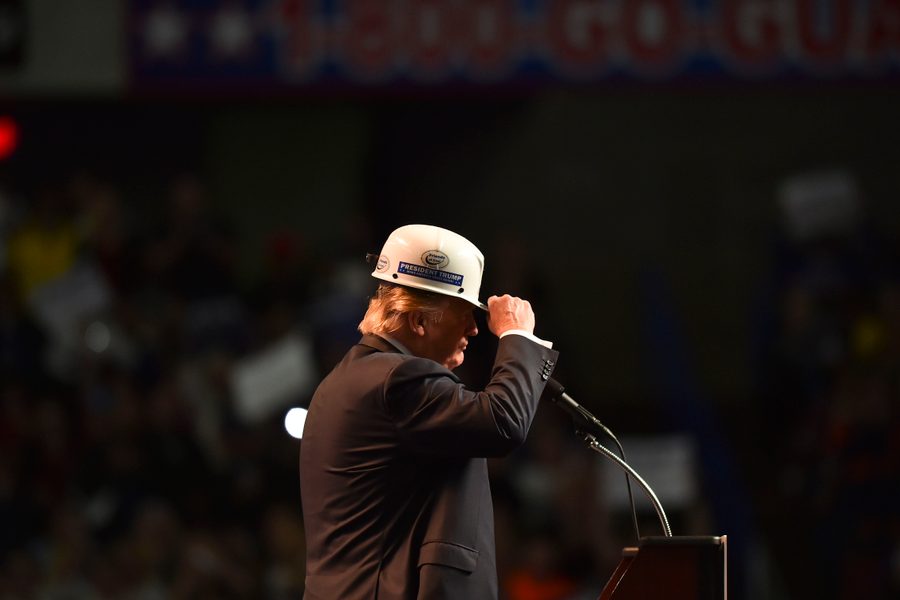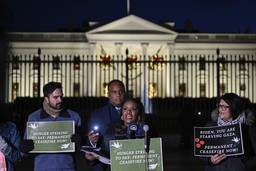Trump Is Using “Welfare” Dog Whistles to Come After the Entire Working Class
Rebecca Vallas, Talk Poverty

On Tuesday night, President Donald Trump signed an executive order that sums up how little he understands about poverty in America.
The order, titled “Reducing Poverty in America by Promoting Opportunity and Economic Mobility,” carries little weight by itself. It directs a broad range of federal agencies to review programs serving low-income people and make recommendations on how they can make the programs harder to access, all under the guise of “welfare reform.”
The order’s main purpose appears to be smearing popular programs in an effort to make them easier to slash — in part by redefining “welfare” to encompass nearly every program that helps families get by. To that end, the order reads as follows:
The terms “welfare” and “public assistance” include any program that provides means-tested assistance, or other assistance that provides benefits to people, households, or families that have low incomes (i.e., those making less than twice the Federal poverty level), the unemployed, or those out of the labor force.
Redefining everything from the Supplemental Nutrition Assistance Program (SNAP, formerly known as food stamps) to Medicaid to Unemployment Insurance to child care assistance as “welfare” has long been part of conservatives’ playbook, as my colleague Shawn Fremstad has pointed out. The term has a deeply racially charged history in the United States, evoking decades of racial stereotypes about poverty and the people who experience it. By using dog-whistle terms like welfare, Trump is erecting a smokescreen in the shape of President Reagan’s myth of the “welfare queen” — so we don’t notice that he’s coming after the entire working and middle class.
The fact is, we don’t have welfare in America anymore. What’s left of America’s tattered safety net is meager at best, and — contrary to the claim in Trump’s executive order that it leads to “government dependence” — it’s light-years away from enough to live on.
Take the Supplemental Nutrition Assistance Program. SNAP provides an average of just $1.40 per person per meal. Most families run out of SNAP by the third week of the month because it’s so far from enough to feed a family on.
Then there’s housing assistance, which reaches just 1 in 5 eligible low-income families. Those left without help can spend up to 80 percent of their income on rent and utilities each month, while they remain on decades-long waitlists for assistance.
And then there’s Temporary Assistance for Needy Families (TANF), the program that replaced Aid to Families with Dependent Children in 1996 when Congress famously “[ended] welfare as we know it.” Fewer than 1 in 4 poor families with kids get help from TANF today — down from 80 percent in 1996. In fact, in several states, kids are more likely to be placed in foster care than receive help from TANF.
Families who do receive TANF are lucky if the benefits even bring them halfway to the austere federal poverty line. For example, a Tennessee family of 3 can only receive a maximum of $185 per month, or a little over $6 a day.
Yet TANF is the program Trump is holding up as a model — hailing 1996 “welfare reform” as a wild success — despite the fact that TANF has proven an abject failure both in terms of protecting struggling families from hardship and in helping them get ahead.
In particular, this executive order directs agencies to ramp up so-called “work requirements” — harsh time limits on assistance for certain unemployed and underemployed workers — which were at the heart of the law that created TANF. But decades of research since TANF was enacted show that work requirements do not help anyone work.
Make no mistake: Pushing for “work requirements” is at the core of the conservative strategy to reinforce myths about poverty in America. That “the poor” are some stagnant group of people who “just don’t want to work.” That anyone who wants a well-paying job can snap her fingers to make one appear. And that having a job is all it takes to not be poor.
But in reality, millions of Americans are working two, even three jobs to make ends meet and provide for their families. Half of Americans are living paycheck to paycheck and don’t have even $400 in the bank. And nearly all of us—70 percent—will turn to some form of means-tested assistance, like Medicaid or SNAP, at some point in our lives.
Trump claims his executive order is intended to eliminate “poverty traps.” But if he knew anything about poverty — aside from what he’s learned on Fox News—he’d know the real poverty trap is the minimum wage, which has stayed stuck at $7.25 an hour for nearly a decade. That’s well below the poverty line for a family of two — and not nearly enough to live on. There isn’t a single state in the country in which a minimum-wage worker can afford a one-bedroom apartment at market rate. Many low-wage workers are forced to turn to programs like Medicaid and SNAP to make ends meet, because wages aren’t enough.
If Trump were really trying to promote “self-sufficiency” — a concept he clearly doesn’t think applies to the millionaires and billionaires to whom he just gave massive tax cuts—he’d be all over raising the minimum wage. In fact, raising the minimum wage just to $12 would save $53 billion in SNAP alone over a decade, as more low-wage workers would suddenly earn enough to feed their families without nutrition assistance.
Yet there’s no mention of the minimum wage anywhere in Trump’s order to “promote opportunity and economic mobility.”
Which brings us back to the real purpose of this executive order: divide and conquer.
Trump and his colleagues in Congress learned the hard way last year how popular Medicaid is when they tried to cut it as part of their quest to repeal the Affordable Care Act. And it’s not just Medicaid that Americans don’t want to see cut. Americans overwhelmingly oppose cuts to SNAP, housing assistance, Social Security disability benefits, home heating assistance, and a whole slew of programs that help families get by — particularly if these cuts are to pay for tax cuts for the wealthy and corporations. What’s more, as polling by the Center for American Progress shows, Americans are less likely to vote for a candidate who backs cuts.
By contrast, vast majorities of Americans across party lines want to see their policymakers raise the minimum wage; ensure affordable, high-quality child care; and even enact a job guarantee to ensure everyone who is able and wants to work can find a job with decent wages. These sentiments extend far beyond the Democratic base to include majorities of Independents, Republicans, and even Trump’s own voters.
That’s why rebranding these programs as welfare is so important to Trump’s agenda. Rather than heed the wishes of the American people, Trump’s plan is — yet again — to tap into racial animus and ugly myths about aid programs in order to pit struggling workers against one other. That way, he can hide his continued betrayal of the “forgotten men and women” for whom he famously pledged to fight.
This article first appeared in Talk Poverty.

I hope you found this article important. Before you leave, I want to ask you to consider supporting our work with a donation. In These Times needs readers like you to help sustain our mission. We don’t depend on—or want—corporate advertising or deep-pocketed billionaires to fund our journalism. We’re supported by you, the reader, so we can focus on covering the issues that matter most to the progressive movement without fear or compromise.
Our work isn’t hidden behind a paywall because of people like you who support our journalism. We want to keep it that way. If you value the work we do and the movements we cover, please consider donating to In These Times.



